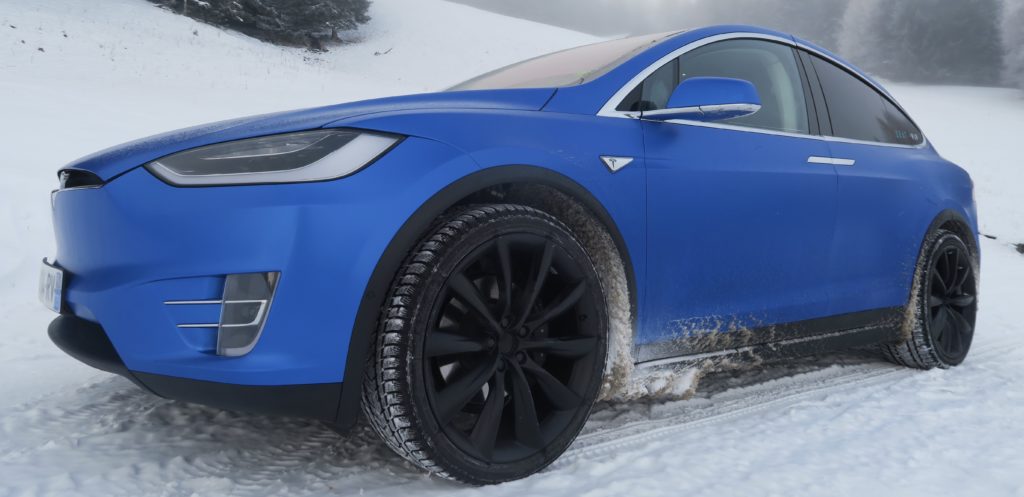Cool Bus Pledge Carbon Net Zero by 2025

We took delivery of our first electric vehicle back in 2016, one of the first batch of Tesla’s Model X SUV’s to arrive in Europe. Through the 2016/17 season we managed to clock up over 40,000 km of passenger transport. We invested in a second and third Model X in 2017 and 2018 and sometime during last summer, our running total of electric kilometres ticked over the quarter of a million mark. It’s a achievement that we are incredibly proud of, representing a reduction of over 60 tonnes of CO2, but we are well aware that it’s not nearly enough and the clock is ticking.
In 2018 we partnered up with Protect Our Winters UK and this autumn, with their guidance, put into place a plan that will see us reach net carbon zero by 2025. It’s a result of the POW UK Pledge scheme that is currently in development to help businesses progress and reach climate goals.

For us, the bulk of the changes we need to make are abundantly clear. We need to switch all of our vehicles to electric and ensure that all the power used for charging comes from sustainable sources.
Right now electric vehicles make up only one eighth of our fleet. We manage to achieve more substantial figures in terms of kilometres by favouring our Tesla’s for any suitable booking (if you book a transfer with us for four or less people there’s a high chance you will get picked up in a Model X). Last month, electric vehicles were responsible for exactly half of the 40 odd transfers we carried out in the Tarentaise Valley but these kind of levels will be impossible to achieve once we get to the business end of the season, when we will be using the majority of our diesel vehicles at least 4 days per week.
We have been keeping a very close eye on the emerging electric car market and placed an order for four of Tesla’s new Cybertrucks within hours of them becoming available last month. The design is definitely coming from far left field but the stats are pretty incredible! Seating six comfortably and with sufficient space in the back for six ski or snowboard bags and suitcases, a range of 800 km and acceleration from 0-60 miles an hour in less than 3 seconds! All of this for just 63,000 euros. The downside being a two year wait until production begins.

Prior to 2016, our fleet consisted entirely of Volkswagen Caravelles. France’s aggressive carbon tax (the Malus Ecologique) has risen steadily over the last five years and now tags on an additional 10,500 euros to the price of a Caravelle. This precipitated our decision early this year to stop investing in new diesel powered vehicles. Our intention is to run down our current stock of Caravelles, filling the gaps left by outdated vehicles with rentals until we are able to replenish with suitable electric models.
Once you tag the Malus Ecologique onto the price of a Caravelle it actually puts it level with the Cybertruck price wise, though still years behind in terms of technology. Having said that, with an additional 3 passengers seats, the Caravelle still has the edge on carrying capacity so we are waiting with bated breath for the launch of a fully electric version. Mercedes have the jump on Volkswagen here and are expected to start taking orders for their electric eight seat people carrier, the EQV, early in 2020 but with a published range of just over 400 km, it’s not ticking our boxes. Fingers crossed this pushes VW into adding 100 km onto that range when they release their much anticipated electric T7 minibus.

But that’s only half the picture of course. As often mentioned in the press, electric vehicles are only as sustainable as the power used to charge them.
When we first started using Tesla’s we took various steps to try and ensure we were keeping this side of the equation in our sights. Firstly we installed 21 solar panels on the roof of our headquarters in Bourg where our cars are charged. To date these have generated 14.2 MWh of power, roughly equivalent to 155 full charges of a Model X. That covers a little over one third of the charging carried out at our base since 2016. A decent start! We also checked with Tesla to find out how they supplied their Supercharging station in Geneva which we use regularly between transfers. They were able to confirm that the source was 100% renewable.
The final step was to look at our local electricity supply. France’s energy mix includes less than 10% from fossil fuel sources, 75% from nuclear and over 15% from renewables. Hydroelectric actually ranks as the countries second largest source of electric power. Our nearest hydro plant happens to be less than 1000 metres from our base, so all good on that front. Or so we thought!

You will have heard of electricity companies that guarantee renewably sourced energy. How does that work? Obviously they don’t run a new cable to your house from a wind farm or hydro plant. All the power is in one grid and you can’t just separate out the sustainably generated bit. These companies operate by ensuring that an equivalent amount of renewable energy is generated to correspond to the amount used by their clients. Sounds dodgy on paper but it can work. As more and more people switch over to green energy companies, so the amount generated from renewable sources will need to increase at the same rate.
But the disadvantage to us is that the power coming from our local hydro plant straight into our sockets might actually be allocated to a consumer in Paris or Bordeaux! That’s why the first step we are taking as part of the POW Pledge is to sign up to a sustainable supplier.
We found Greenpeace France’s guide very useful which you can find here: https://www.guide-electricite-verte.fr That lead us to choose Energie d’Ici as our new supplier and in November we made the switch. Their prices are actually fractionally lower those we currently pay to EDF. If you live in France we’d urge you to give them a look and consider making the switch. All you need to do is simply complete one form and they take care of the rest.

Of course the action doesn’t just stop there and POW UK have plenty more steps to their Pledge scheme. We will be publishing regular updates throughout the coming years so people can follow our progress and hopefully be inspired to do similar within their own business or personal lives. One of the big issues we will need to tackle in the near future is putting in place the infrastructure to allow us to keep a full fleet of cars charged. It’s going to take some planning but we’re certain it can be done!
Of course, the elephant in the room is the fact that the flights you take to the Alps are a much bigger part of the problem. Traveling by train is way better for your carbon footprint but right now there are nowhere near enough train seats available to cope with the demand from holiday makers traveling from the UK. That means for the near future people are going to continue flying and as long as they do, we will be there offering a more sustainable option to get from the airport to resort. And yes, we do offer transport from the train stations up to resort as well!
